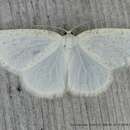Conservation Status
provided by University of Alberta Museums
Not of concern.
- license
- cc-by-nc
- copyright
- University of Alberta Museums
Cyclicity
provided by University of Alberta Museums
The peak adult flight occurs throughout June.
- license
- cc-by-nc
- copyright
- University of Alberta Museums
Distribution
provided by University of Alberta Museums
Nova Scotia to BC and southern NWT, south to Colorado (McGuffin 1972).
- license
- cc-by-nc
- copyright
- University of Alberta Museums
General Description
provided by University of Alberta Museums
"One of a number of similar looking, faintly marked white geometroid moths. The wings are cream-white and unmarked except for a fine specking of brown scales, particularly along the costa. No trace of discal spots or transverse lines. Very similar to Cabera variolaria, but in virginalis the male anntenal pectinations are much shorter, the frons (face) is cream not yellow and white, and the forelegs are grey not tan. Eudeilinea herminiata (Drepanidae) is similar but lacks any trace of the tan-scaled speckling.
Subspecies hulstiaria Taylor has reduced speckling and a visible PM line; once treated as specifically distinct from virginalis, McGuffin (1972) considered it a clinal form of virginalis. Whether form hulstaria occurs in the southwest Alberta mountains remains to be documented; Prentice (1963) shows it occuring in BC east to the AB border.
"
- license
- cc-by-nc
- copyright
- University of Alberta Museums
Habitat
provided by University of Alberta Museums
Mesic deciduous and mixedwood forests.
- license
- cc-by-nc
- copyright
- University of Alberta Museums
Life Cycle
provided by University of Alberta Museums
McGuffin (1972) details the immature stages. Adults come to light and are often common.
- license
- cc-by-nc
- copyright
- University of Alberta Museums
Trophic Strategy
provided by University of Alberta Museums
Larvae prefer trembling aspen (Populus tremuloides), but also feed on other poplars and willows (Salix spp.) (Prentice 1963).
- license
- cc-by-nc
- copyright
- University of Alberta Museums
Protitame virginalis
provided by wikipedia EN
- license
- cc-by-sa-3.0
- copyright
- Wikipedia authors and editors
Protitame virginalis: Brief Summary
provided by wikipedia EN
Protitame virginalis, the virgin moth, is a moth in the family Geometridae. The species was first described by George Duryea Hulst in 1900. It is found in North America.
The MONA or Hodges number for Protitame virginalis is 6270.
- license
- cc-by-sa-3.0
- copyright
- Wikipedia authors and editors

